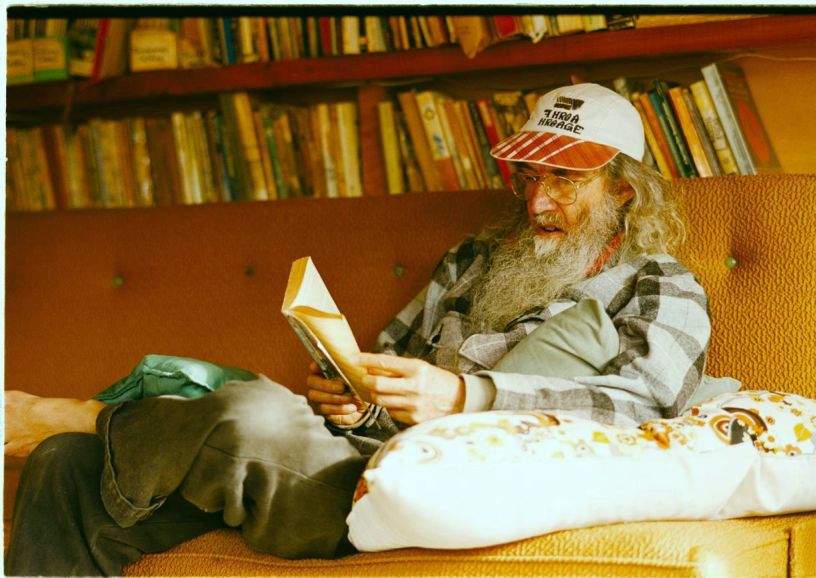Tuesday Mar. 17, 1992; front page feature.

Footing the Family Food Bill
^^^^^^^^^^^^^^^^^^^^^^^^^^^^
by Helen Matterson
Tuesday Mar. 17, 1992; front page feature.

Footing the Family Food Bill
^^^^^^^^^^^^^^^^^^^^^^^^^^^^
by Helen Matterson
![[colour photo, David MacClement on road: long dark hair, long beard, red backpack, bare feet]](shoprgbs.jpg)
A Greenhithe man is walking 16km barefoot each week to buy his groceries as part of his family budgeting plan
And David MacClement (56 in '92) backpacks 28kg of food [8km] from Glenfield mall in a cost-cutting exercise which sees a family of five, including two teenagers and a 20-year-old, living on NZ$299 [US$170] a week.
Mr MacClement, who hasn't bought any new clothes for five years, makes his journey barefoot to save wear and tear on his jandals, which he takes with him for rough ground. The weekly supermarket bill, buying food, toiletries and cleaners, seldom costs more than NZ$125 [US$71].
His philosophy is that a quarter to a fifth of the world's people are squandering the planet's wealth. He believes the world's population could live on US$2,000 each, a year. In 1988 the MacClements spent five months in India to show their children what it was like to live in real poverty and appreciate their New Zealand lifestyle.
When they returned he continued teaching physics in a secondary school, but after a nervous breakdown, left.
Mr MacClement's wife is a scientist; the family lives off her part-time incomes from laboratory supervision and tutoring at Auckland University. [in 1992. Physics lecturing, later]
Mr MacClement is registered unemployed; he does not collect the dole. [in 1992. In 1998, not registered and living off savings. In 2002, is getting N.Z. Superannuation ($180 p.w., $9,413 p.a).]
Because their house is paid off, the family can make food 40% of their total costs.
Most families are limited up to 30-33%(*) because of rent and mortgage payments.
Mr MacClement keeps meals simple, based around a starch diet of potatoes, rice and pasta rotated. Vegetables provide variety, and are bought from a local co-op for NZ$22 [US$12.50] each week. Meat is eaten rarely and in the form of a sausage each or an equivalent portion of ground-beef.
Breakfast is Weetbix or toast, and cut lunches feature spreads, lettuce and cheese. Twelve loaves are bought each week.
He says he is much fitter and the walk has added five years to his life. And he's proud of how his children have accepted the idea although it is not something they readily brag about to peers.
Budgeting has turned into a meticulous affair with Mr MacClement spending hours at his computer putting the family's spending onto spread-sheets.
[in 1992. In 1993, realised we just had to think three times before buying anything, and if in doubt, don't (buy).]
His religious control of spending has paid-off with the weeks total costs still declining. But there is a limit.
"To go any further would be a strain."
We can't afford to be complacent. Doing nothing actually puts us on a course going backwards.
Organic foods may be one way of building a more prosperous food industry.
How about new biological industries, that aren't necessarily about food? Why do we use all our dairy cows as milk factories? Another option is as a pharmaceutical laboratory.
'Viagra' could possible be the world's biggest science and technology news story in the last decade. It has certainly made the cover of the many international magazines. Not in New Zealand though. Here it seems Viagra is more likely to spawn jokes about stiff necks for those who have trouble swallowing, than enthusiasms for investing in pharmaceutical enterprises. When you combine Viagra with Propecia, the obesity drug (I've forgotten the name), and Prozac, and you get a picture that indulging our vanity is actually a pretty big market these days.
When you look across the OECD, and the fate of personal discretionary
expenditure, the percentage spent on food has dropped from about 33% to 16% over the last 40 or so years, while the percentage spent on 'health care' (including indulgences like Viagra) has increased from 6% to 16%.
Should that be a message to our wealth-seeking biological industries?
Dr James Buwalda
Chief Executive
Ministry of Research, Science & Technology
| The July 2004 (winter) photo of me reading to two others, in the furnished end of our barn: |
 |
| This image is at:>> https://davd.tripod.com/DM-040723-816x578.jpg << |
|
|
Please send any questions or comments to the site Editor |